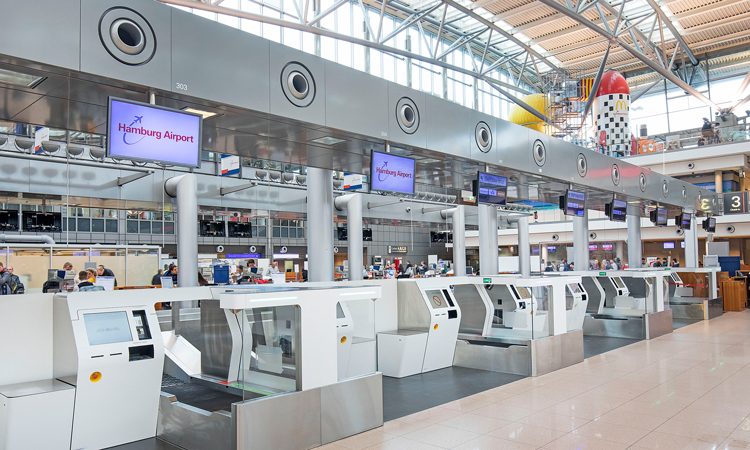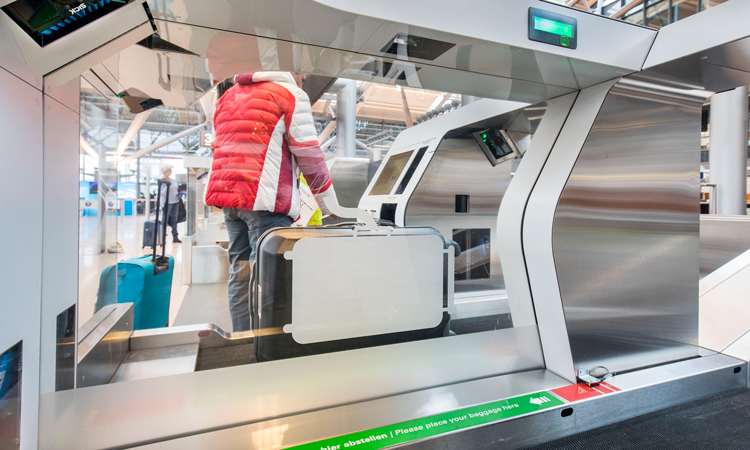Hamburg Airport takes another step towards the future
- Like
- Digg
- Del
- Tumblr
- VKontakte
- Buffer
- Love This
- Odnoklassniki
- Meneame
- Blogger
- Amazon
- Yahoo Mail
- Gmail
- AOL
- Newsvine
- HackerNews
- Evernote
- MySpace
- Mail.ru
- Viadeo
- Line
- Comments
- Yummly
- SMS
- Viber
- Telegram
- Subscribe
- Skype
- Facebook Messenger
- Kakao
- LiveJournal
- Yammer
- Edgar
- Fintel
- Mix
- Instapaper
- Copy Link
Posted: 18 June 2019 | Michael Eggenschwiler | CEO | Hamburg Airport | No comments yet
Passengers can benefit from even more independence and flexibility at departure with Hamburg Airport’s self bag drop. Michael Eggenschwiler, Chief Executive Officer, Hamburg Airport explains how the experience of the technology to date leaves no doubt that automated baggage check-in is the right solution for the future.


At Hamburg Airport a total of 20 fully-automated baggage check-in stations have been in operation in Terminal 1. The first 10 self-bag-drop kiosks were officially launched at the start of 2018 and the new service was so well-received among passengers that a further 10 kiosks were installed at the start of April 2019.
What makes them special is that these self-bag-drop kiosks are not specific to an airline, but technologically designed to provide the service for all. Since launch, the innovative service has been offered to passengers of easyJet, Air France and KLM. Since December 2018, passengers from Eurowings – the biggest airline in Hamburg in terms of passenger numbers – have also been able to check in their bags automatically.
SAS Scandinavian Airlines and Turkish Airlines are connecting to the new system, meaning that the majority of Hamburg passengers can use the kiosks, while other airlines have also expressed interest.
The numerous advantages became apparent for passengers and airlines alike once the system entered operation. With self bag drop, passengers benefit from even more independence and flexibility at departure. The aim is to optimise the travel experience of passengers and offer time-saving processes. Waiting times at check-in can be avoided, and the self-explanatory kiosks are quick and easy to use.
The queues at traditional check-in counters are shorter and passengers are no longer governed by the counter opening times. They have more time to stroll, shop and visit the restaurants. The result is a consistent levelling out of check-in, with demand peaks at the subsequent security checkpoint avoided too.
Counter opening hours are now irrelevant
Flight operations at Hamburg Airport take place between 06:00 and 23:00. The self-bag-drop kiosks are in operation between 04:00 and 21:00. Therefore, passengers who arrive a long time before the counters open can check their bags in without having to wait. Without luggage, the passenger can pass through the security checkpoint early and spend the time before departure relaxing in the shops, lounges, bars and restaurants. Self bag drop can also take over the functionality of late-night advance check-in.
Fully-automated baggage check-in means reduced costs for the airlines as they do not have to acquire kiosk terminals themselves (and the maintenance is the airport’s responsibility). The airlines only pay for the services used by their passengers. Ever since the first baggage kiosks entered operation, easyJet has been using the new system exclusively. The other airlines still accept baggage at their classic check-in counters, but the airport offers personal support from well-trained staff at the kiosks too.
Passenger response
Feedback from passengers has, unsurprisingly, been positive. Anyone using the automated baggage check-in quickly realises how easy the system is. It is straightforward and self-explanatory. It is clear that self bag drop is part of the future of aviation. It is becoming an increasingly standard component in more relaxed travel.
User-friendly and with the maximum possible comfort for passengers and airlines whilst fulfilling the highest security standards: These were the most important technical requirements imposed on the system’s manufacturer. Hamburg Airport chose a leading IT service provider with more than 1,900 employees around the world: Materna GmbH from Dortmund in North Rhine-Westphalia.
The specifications for self bag drop included demanding requirements in terms of design as well as technology. The solution adopted fits well with the architecture and atmosphere of the terminal.


The kiosks automatically identify things that cannot be transported using the system, including prams and rucksacks with straps that could potentially block the system
Simple and self-explanatory operation
The user guide for the automatic baggage check-in is simple. First, the user selects the airline on the screen and then scans the boarding pass. The next step is to answer security questions about the contents of the baggage. Then, the bag is placed within a marked area on the belt. The kiosk then prints the baggage tag with the barcode to be affixed to the baggage which has to be confirmed on screen. Finally, the passenger takes the baggage receipt.
Baggage cannot be transported onward on the conveyor belt until it is correctly labelled. A scanner identifies errors or misuse of the kiosk immediately and the glass doors only open when an item of baggage has been identified as safe. As soon as the baggage reaches the conveyor belt, it follows the standard route behind the scenes through the airport, eventually reaching the aircraft, ready for loading.
Capacity for more than four million items
For someone familiar with the kiosk, checking in a bag only takes around 60 seconds. The 20 kiosks can therefore process around 1,200 bags per hour. In the course of a year, this gives them a capacity for more than four million items of baggage. More kiosks can be added as needed. A key advantage: The system saves space. This is especially important for an inner urban airport such as Hamburg, where space for infrastructure optimisation is limited.
Hamburg Airport: A pioneer
Hamburg Airport has taken a pioneering role in the deployment of self-service systems in Germany. The first self-bag-drop kiosks were introduced four years ago. The 20 new kiosks, however, have additional features such as baggage classification. The kiosks automatically identify things that cannot be transported using the system. The passenger is then informed via the display that the item is to be checked as oversized baggage. This applies, for example, to prams and strollers, as well as to trekking rucksacks with straps that could potentially block the system.
Checked items are automatically photographed. In the event of damage or loss, for example, this makes it easier for the passenger to prove that the baggage was in good condition when it was checked in. The self-bag-drop system is based on the international CUSS standard (Common Use Self-Service). This allows airlines to deploy their own applications on self-bag-drop equipment around the world without having to redevelop or adapt.
Combining latest technology with real people
Hamburg Airport uses a combination of the latest technology and real people on site to assist passengers, and the approach has been very well received. Well-trained, friendly personnel are always on hand to provide help when asked – at fixed service locations such as the Hamburg Welcome Centre, the Infopoints and in the terminals.
In 2016, Hamburg Airport established a Mobile Service Team to take care of passengers. The team of 12 has been out in the terminal ever since, helping passengers find their way and answering questions about the airport – including questions about the self-bag-drop service. The airport’s goal is for every passenger to feel well supported. Regular passenger surveys show that Hamburg Airport is on track with this goal.
The future of modern aviation
The popularity with passengers and the interest expressed by other airlines have led Hamburg Airport to plan a further expansion of the self-bag-drop service. A further 10 kiosks are already due to enter service in Terminal 2 in 2020.
Biography
Michael Eggenschwiler, Chief Executive Officer of Flughafen Hamburg GmbH, was appointed to the Executive Board of Hamburg Airport in 2003 and has served as CEO since 2005. He commenced his studies at the University of St. Gallen in 1977 and in 1983 began his career as an Assistant to the Executive Board at the Swiss airline, Crossair. Eight years later, having reached the Executive Board himself, he departed Crossair for Swissair. Over a period of 10 years there he held several senior management positions. In 2002 Eggenschwiler left Swissair to become a partner in the management consultancy MAB Consulting in St. Gallen.
Related topics
Baggage handling, Information technology (IT), New technologies, Passenger experience and seamless travel, Self-service, Terminal operations


















